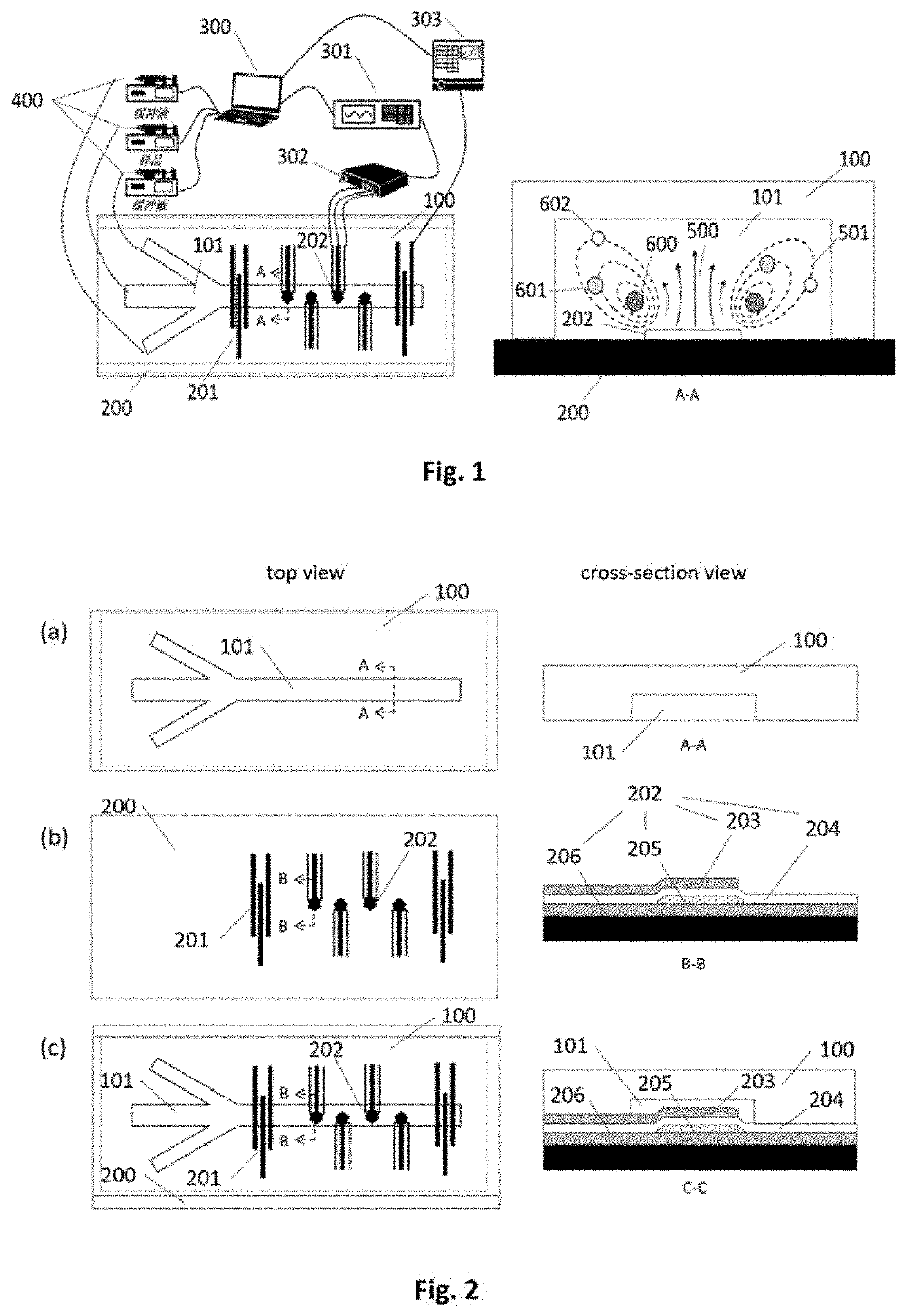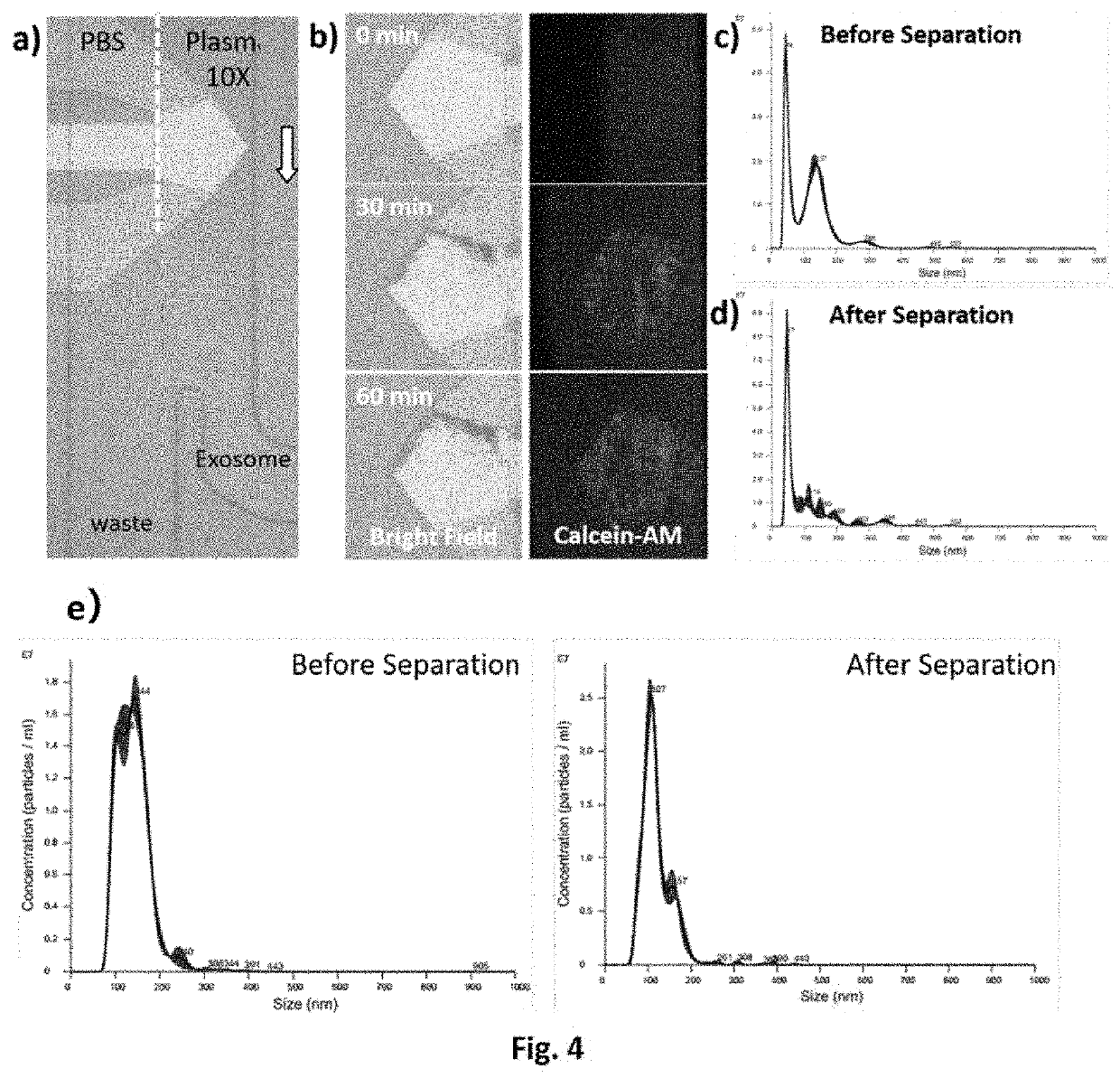Separation method and apparatus for microvesicles
- Summary
- Abstract
- Description
- Claims
- Application Information
AI Technical Summary
Benefits of technology
Problems solved by technology
Method used
Image
Examples
example 1
Experimental Method and Materials
[0095]Microfluidic channel and UHF bulk acoustic resonator preparation:
[0096]Microfluidic channels made of polydimethylsiloxane (PDMS) were prepared by soft lithography.
[0097]The bulk acoustic wave resonator devices are prepared by chemical vapor deposition, metal sputtering, and lithography on a silicon wafer. The specific methods are as follows.
[0098]1. The surface of the silicon wafer is thoroughly cleaned using a solution with a 3:1 volume ratio of concentrated sulfuric acid to hydrogen peroxide, which effectively removes organic and inorganic materials from the wafer.
[0099]2. On the cleaned silicon wafer, an aluminum nitride film is formed by surface sputtering, and then a silicon dioxide film is deposited using an ion-enhanced chemical vapor deposition method. Then, using the same method, the aluminum nitride film and the silicon dioxide film are deposited alternately to form a Bragg acoustic reflection structure with alternating layers of alum...
example 2
[0109]In this embodiment of the present invention, a microfluidic device is provided which can be used to separate and capture flexible particles in solution. The flexible particles may be artificial or natural. The flexible particles may be biomolecular particles such as nucleic acids. The flexible particles may also be microclusters with a membrane structure, in particular microclusters with a lipid bilayer or a lipid-like bilayer. In one aspect of the present invention, the flexible particles are nature, such as cellular vesicles that are released by cells into the extracellular environment, including exosomes, microvesicles, vesicles, membrane vesicles, prostatic vesicles, microparticles, intraluminal vesicles, intranuclear body-like vesicles, or cytosolic vesicles.
[0110]The method and devices of the present invention can be used to separate and capture flexible particles in solution, for example to separate and obtain microvesicles in blood.
[0111]As shown in FIG. 1, said microf...
example 3
Effect of Flow Channel Height on Acoustic Jets and Vortices Induced by Bulk Acoustic Waves
[0142]Observations were made on the acoustic jet and / or vortex currents generated by the UHF bulk acoustic wave resonator used in the present invention in microfluidic channels of different heights. The microfluidic channels of the present invention which are suitable for separating cellular microvesicles (20-800 nm) including exosomes (about 20-250 nm) have a suitable height of no more than 60 μm, e.g. 60 μm, 40 μm, 20 μm.
[0143]In this case, hollow glass beads (with a density close to water) were added to the fluid cavity to characterize the fluid velocity distribution by particle motion trajectories.
[0144]The results are shown in FIG. 3. In the 3 photographs, the microfluidic channel size decreases sequentially from the top, middle to the bottom photograph.
[0145]The photos were taken by a high-speed camera at 5000 fps and combined with 100 frames. Each line segment in the figure represents th...
PUM
 Login to View More
Login to View More Abstract
Description
Claims
Application Information
 Login to View More
Login to View More - R&D
- Intellectual Property
- Life Sciences
- Materials
- Tech Scout
- Unparalleled Data Quality
- Higher Quality Content
- 60% Fewer Hallucinations
Browse by: Latest US Patents, China's latest patents, Technical Efficacy Thesaurus, Application Domain, Technology Topic, Popular Technical Reports.
© 2025 PatSnap. All rights reserved.Legal|Privacy policy|Modern Slavery Act Transparency Statement|Sitemap|About US| Contact US: help@patsnap.com



